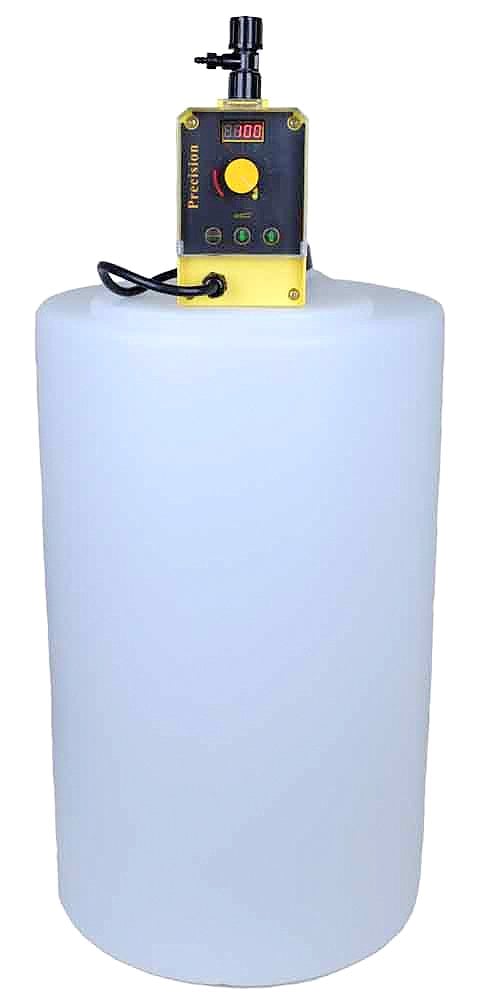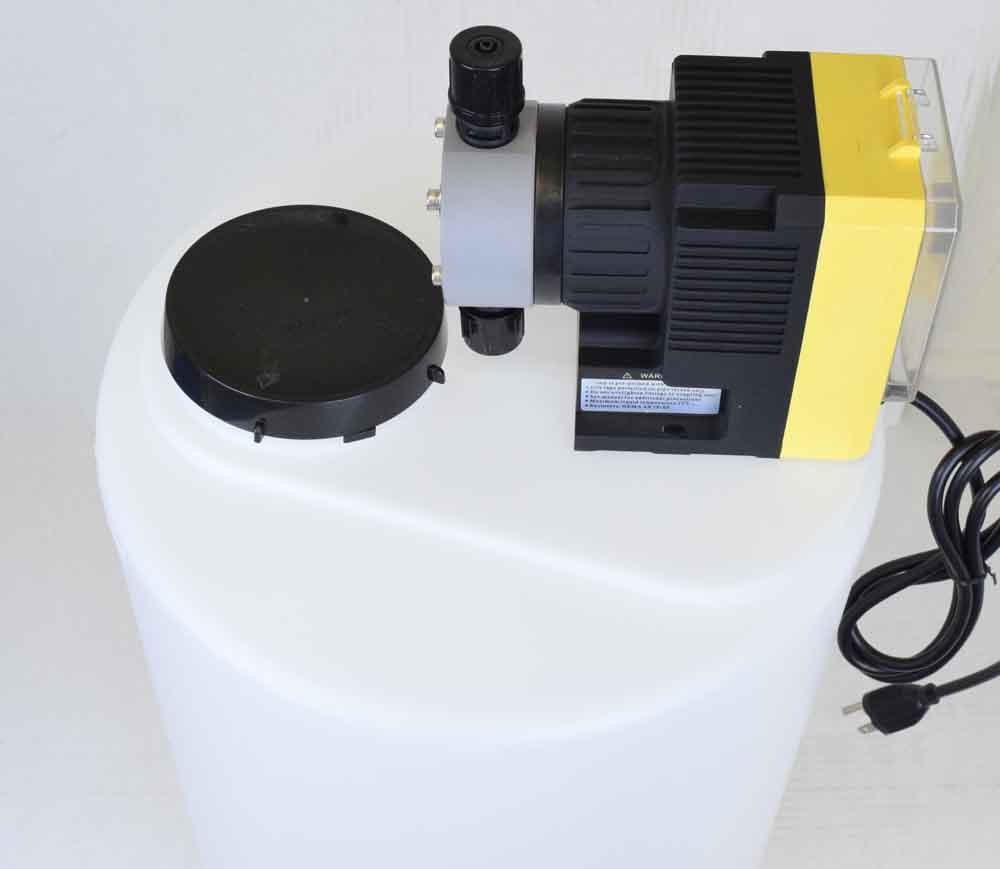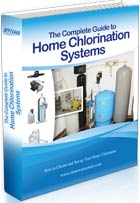Many residential water wells require a chlorine bleach injector , also known as a chlorinator, either to kill bacteria, to eliminate odors, pre-treat the water for iron removal, or to treat iron bacteria. This article describes the simple steps one should take before selecting and installing a home chlorinator.
Common household bleach can used in an automatic chlorinator system to kill coliform bacteria and provide disinfected water. In some wells iron or sulfur bacteria can create ‘rotten egg' odors and cause staining of fixtures and appliances. Chlorinators can also be used to address these problems.
The first step in selecting a chlorinator is to find out your basic water chemistry and have your well water tested. A general mineral analysis will provide a list of the common minerals (calcium, magnesium, iron, manganese, dissolved solids) alkalinity and pH. The pH is important because the higher the pH the more chlorine is required.
How Much Chlorine Should I Plan to Add?
Chlorine is injected in parts per million (‘ppm') which is the same as saying milligrams per liter (‘mg/L'). For bacteria you want 1 to 2 ppm of chlorine and approximately 10 minutes of contact time. If the water is colder than 50F (10C) and/or the pH is higher than 7.5… you may need longer contact time.
For each part per million of iron or manganese you want to inject 1 ppm of chlorine. For each 1.0 ppm of hydrogen sulfide gas (which causes the rotten egg smell in water) you want to inject 2 or 3 ppm of chlorine.
So say you have bacteria and 2.0 ppm of iron. For our example here, we will assume you want to inject 3 ppm of chlorine.
How Do I Know What Size Chlorinator Pump to Install?
The next step in selecting your metering pump is to know how many gallons per minute your well water is flowing… at the point where you will be injecting the chlorine. Usually the best place to inject the chlorine is before the pressure tank. Unless you have a variable-speed pump, your water at this point is flowing in approximately the same flow rate every time the well pump turns on. After you use up your reserve in your pressure tank, the pressure switch turns on the well pump and the water begins to flow from the well.
You can easily calculate the flow rate at this point by following these steps:
- 1. Open any hose bib or faucet until pump turns on.
- 2. Close hose bib or faucet and let pump fill up pressure tank until it turns off.
- 3. Using a 1 or 5 gal. bucket, open faucet, collect and measure all water discharged until pump turns on. Let us say this amount is 20 gallons.
- 4. When pump turns on, immediately close faucet and start timing pump cycle.
- 5. When pump turns off, record pump cycle time to refill pressure tank in seconds. Let us say this figure is two minutes or 120 seconds.
- 6. Divide the number of gallons collected in Step 3 by the number of seconds in Step 5. 20 divided by 120 is 0.166
- 7. Multiply the answer from Step 6 by 60, which comes out to 10.
- 8. The answer in Step 7 is the average pumping capacity of the pump in gallons per minute (GPM).
Now that you know the amount of chlorine you want to install (3 ppm) and the flow rate of the water stream you are injecting the chlorine into (10 gallons per minute) you are finally ready to calculate the size of the metering pump!
How Strong Should the Chlorine Bleach Solution Be?
Use unscented chlorine laundry bleach (which is typically about 5% chlorine) and dilute it by adding 9 gallons of water to 1 gallon of bleach. This will give you a solution strength of approximately 5000 parts per million of chlorine. Use purified or at least softened water for making up your solution. Unless your well water is very soft and low in minerals, do not use your raw well water. You won't be using much solution, so it is not expensive to pick up some gallons of distiled water for this purpose from the grocery store.
How To Size the Chlorine Metering Pump
Metering pumps are often rated by the amount of chlorine solution they can pump by gallons per day, or by the amount of solution they can pump by hour. They have adjusting knobs so you can pump the full output or turn the pump down to deliver up 90% less than the output. So turned up all the way the pump puts out 100% of its output, or you can adjust it down to some percentage less than 100%.
The formula is simple: multiply the flow of the water (in Gallons Per Minute “GPM”) times the Applied Dosage (in Parts Per Million “PPM”) and them multiply this by 1440 (the number of minutes in one 24 hour period). Finally divide this number by the solution strength being used.
10 GPM x 3.0 PPM x 1440 divided by 5000 = 8.6 Gallons Per Day
At this rate you can select a metering pump that can pump 10 gallons per day and adjust the output of the pump to 86% to achieve the desired 8.6 gallons per day. Finally you can test the chlorine residual at the kitchen sink. Your goal should be to have a residual of 0.2 to 0.8 ppm of chlorine.
If you find the residual is too high, you can adjust the metering pump down to deliver less or dilute the chlorine solution with more water. If you find the residual is too low, you can make the solution strength stronger by using less water to dilute the solution, or you can turn up the output of the metering pump.
Which Metering Pump is Best?
Choose a quality metering pump that is corrosion proof, easy to prime, and can pump at a high enough pressure to overcome the pressure of the pipe that the chlorine is being pumped into. The Precision-24 Metering Pump has a degassing valve on it, that prevents gas bubbles from causing the pump to lose pressure, and helps it make it very easy to prime.
Liquid chlorine (bleach) is injected right out of the well, before the pressure tank. Often a contact tank is used to allow sufficient contact time.
Typical installation showing chlorine bleach pump injector, on a standard well pump and pressure tank. Also see proportional feed chlorinators for installing the injector after the pressure tank, or if your well has a variable speed well pump.
See our online calculator: How to Determine Flow Rate for Wells with Pressure Tanks
See our Chlorine Metering Pump Calculator
Questions? Fill out our quick and easy Customer System Designer Form and get a response is 24 hours or less.
Also see our Chlorination Work Sheet and Calculator
Proportional Chlorinator Digital Pulse UP
Precision Chlorinator-Tank
Precision Pump Install
Contact Tank Diagram
“Why Use a Chlorinator For Well or Spring Water?”
Now for a limited time we will send you our “The Complete Guide to Home Chlorination Systems” for FREE (reg. $39), and include a $25 COUPON!












